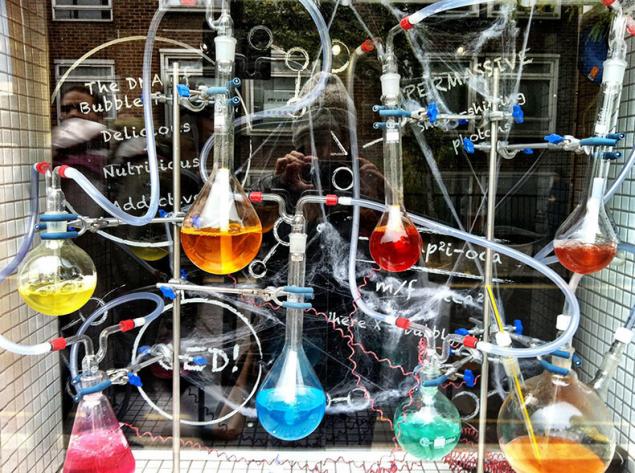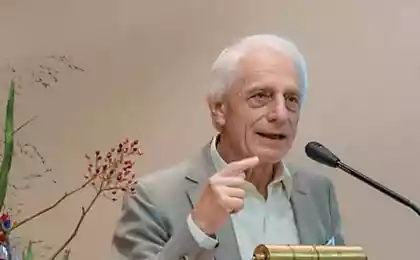1000
On the same wavelength: Neurobiology of harmonious relationships
"The significance of borders exaggerated" - so begins Amy Banks his book "On the same wavelength. Neurobiology of harmonious relations. " In our culture to say that a successful person - the one who does not need other people. If you show that you need someone, you show your weakness. But recent discoveries of neuroscience show that the constant alignment of the boundaries between people of our unnatural nature.

Amy Banks, a psychiatrist and author of "On the same wavelength. Neurobiology of harmonious relations »
A new area of research called neurobiology relationships I showed that there is a certain innate system in the human body, which consists of four major neural pathways and allows us to maintain an emotional bond with other people. Furthermore, according to the neurobiology relationship detachment it affects people of neural pathways. As a result, there comes a cascade of neurological reactions that can lead to chronic irritability and anger, depression, addiction and chronic somatic diseases. The human brain is arranged to operate under the warm human relations.
Thus, the relationship affect the structure of the brain. If you've ever tried to ignore the influence of other people on your life, it's time to reconsider its position, taking into account this fact.
The book is written primarily for people who want to solve their personal problems building relationships with others, whether family, friends or colleagues. It sets out C.A.R.E. program that Amy Banks applied for about 15 years while working with their patients.

Neuroscience shows that the need for lots of fun given to us by nature.
Program C.A.R.E. It takes into account four important aspects of healthy relationships that are associated with the four neural pathways. "C" - is calm (calm), how easily we feel surrounded by other people. For it is in a reasonable vagus nerve. «A» - acceptance (accepted), whether people accept us, we feel part of the group; it depends on the dorsal zone of the anterior cingulate cortex. «R» - resonance (resonate), we resonate with their inner world; this aspect of the work depends on the mirror of the nervous system.
And, finally, «E» - energy (energize), these contacts charge us with energy. The latter is provided by the dopamine reward system. Yes, a healthy relationship - a natural doping, which helps to actively live, learn and work
. If the dopamine reward system is not related to healthy relationships, the brain is looking for other ways to have fun, and so are other ways to stimulate the dopamine system. These "other ways" are well known to all of us: overeating, alcohol and drug abuse, compulsive sex, shopping, risky, gambling
. As you can see, the inability to build relationships with people is fraught with deconstructive consequences. What is the opinion of the author, a healthy relationship? It's simple: it is a relationship that gives you energy for the development of
. Before I give you a book fragment, I would like to point out why it can be especially useful for teachers and parents.
Often communication problems remain in school for a lesson framework, and the importance of good relations in the classroom for every student success is clearly underestimated. Moreover, almost every teacher met in my practice, children who are prevented to be successful qualities such as irresponsibility, aggression, isolation. Maybe these kids just do not know how to build relationships? Or entire classes who stubbornly silent on the seminars and not included in your exciting educational venture. Perhaps the disciples did not believe the relationship with you and each other safe enough?
In short, work on interpersonal relationships may be a necessary step for the solution of many problems. Just learn and learn to get pleasure from them.
Three rules of brain development
There are certain rules changes in the brain that can be used to solve the problems of neural pathways resumption C.A.R.E. and the strengthening of relationships with other people.
Rule №1. Use or lose.
A number of discoveries about the brain made at the turn of the 20th and 21st centuries, has led to a method of treating disorders of the nervous system provoked. All of these methods of treatment allow to re-build neural pathways and are becoming more common, especially in rehabilitation centers and offices rehabilitators.
In other areas, including in the offices of therapists, still not familiar with them.
If your neural pathways responsible for communication, do not work the way you want to, you can change them.
The turning point event occurred in 1997, was the study of Peter Eriksson - Swedish neuroscientist, who proved that the adult brain can produce new neurons. Prior to that, it was believed that the adult brain is like the hair on balding skull although losing neurons as we age it is only natural and is not always a symptom of a disease, you can not grow them again. Opening Eriksson caused a lot of effects, but the most important was that it gave impetus to the development of an entirely new field of research - neuroplasticity
. It turns out that the adult human brain can be varied in many ways, similar to a soft plastic polymer can compress and stretch to give it the desired shape. The analogy with the hardware is no longer consistent with the known facts. The brain is not an immutable quantity. It is more versatile and flexible than anyone could have imagined. And more lively.
Neural paths constantly reacting to the external environment. When repeated stimulation of a neural path it becomes stronger. It produces more myelin, which speeds up the passage of electrical impulses across the way, as well as produce more branches, making the path wider.
(If you look through a microscope, then the path to a good cross pulses are so many branches that it resembles Einstein's shaggy hair disheveled.)
In addition, the neural pathways compete with each other, so when you are increasingly using some certain way, other ways to die. As a result, there is less of alternative neural pathways for transmission of electrical impulses. Instead of scattered several smaller waterways, increasing the number of pulses transmitted through neural pathways with good maneuverability.
Neuroplasticity allows us throughout life to form new neural connections, and thus change their habitual behavior.
However, if the neurons are not stimulated long enough and your brain does not feel the need to use them, they can weaken.
If you look at the brain of a person who has ceased to oversee one of the parts of the body due to its amputation or paralysis, you would see that in the "map" of the brain is no more paths leading to this part of the body. However, the area in which previously ran the way, is not empty and is filled by other routes passing nearby, using abandoned areas of the brain.
Rehabilitation professionals adhere to the rules of "use it or lose it" in the new protocols for stroke treatment. Rather than simply teach patients how to compensate for the lost function, doctors stimulate neural pathways to the paralyzed part of the body, again and again, developing it.
The rule "use or lose" works well in cases where the relationship between human beings are subject to a certain scheme. This can be seen in the long-married couple, who have forgotten how to discuss problems without wrangling and acrimonious remarks: for the marriage neural pathways for these habits become rigid and inflexible
. The same thing happens when a woman is found only with men who have an increased craving for alcohol. In all likelihood, this makes itself felt psychological similarity effect (perhaps these parents sinned this woman), but the neurological factor is also present. The neural pathway formed in the brain of the woman as a child, which led to the creation of a model in which important relationships are associated with alcohol. In keeping with the model in adult life, she is doing a kind of neurological track over and over again by selecting the same preferences and behavior of the line, until the alternative path is not weakened due to non-use.
Rule Action "use it or lose it" is also observed in cases where someone is taking something that at first glance does not seem characteristic of his nature. Quiet man moves to the big city to become more courageous, selfish going through the ordeal, and he develops empathy.
A change in circumstances leads to a change in the neural pathways.
Rule №2. At the same time excites neurons form stable relationships
Like people, neurons become stronger if combined into a group. When neurons are located next to each other, repeatedly excited at the same time, then they establish a connection with each other and form a fragment of a neural network or neural pathways.
A neuron consists of a core of axons and dendrites. Send axons and dendrites receive signals from other neurons. Axons and dendrites as stretch hands to each other from different neurons. (This is a "handshake" takes place in a space called the synapse, neurotransmitters which secrete chemical messengers, passing from neuron to neuron.)
The immature nervous system is holding hands looks simple enough. You can imagine the following picture: A neuron holding the hand of a neuron B, who holds the hand of neurons in the - in the children's game where kids hold hands
. However, due to stimulation with time longer in neurons formed axons and dendrites, which stretch arms many other neurons to form a complex neural network.
Direction of neural pathways, as well as their degree of difficulty is partly due to the DNA of individual neurons. However, a new field of science called epigenetics suggests that DNA expression largely depends on the stimulation that the neurons receive from the external environment.
But aside from the DNA, your neurons and neural pathways are also formed under the direct influence of external factors trigger.
Take for example the path which runs from the motor cortex to the index finger of his right hand. Each of us this way is present from birth. When a child is learning to play the piano, repeatedly stimulates this way, it is amplified and it is formed larger axons and dendrites - this is usually "use or lose" in action
. However, all of these axons and dendrites is not just hanging out doing nothing. They establish a relationship and "holding hands" with other neurons; if you speak the language of neuroscience, they recruit other neurons from neural pathways. On CT scan of the brain concert pianists can be seen that the neural pathways to their fingers strongly interdependent; and the axons and dendrites of neurons relevant are so closely intertwined that the entire arm acts as a unit rather than as five separate fingers, hand and wrist.
This is due to the interconnectedness of multiple simultaneous stimulation of different parts of the hand. Over time arms neural network connects to this path more neurons. Sami neurons also increased slightly, because they have a lot of processes, however, the density of neuronal growth path due to the fact that this is the way more and more friends who join this neural network.

The regular repetition of the same acts - the basis of not only physical training
. If such a neural path is used frequently enough, it will take up less physical space in the brain. The reason is not that he is weakened, and the fact that gains in strength that it becomes much more orderly and efficient, just as flabby body looks slim and fit.
So the second rule changes in the brain: both excitatory neurons form stable relationships
. Rule №3. Repetition, repetition, dopamine.
Almost twenty years ago, I attended the first conference on the neurobiology of posttraumatic stress disorder (PTSD). At that time, I have been actively studied issues related to the emotional trauma and violence.
I was very interested to hear how many of the leading researchers in the field will present their part of the neurobiological puzzle.
The results were striking. It turned out that people suffering from PTSD have been violations of the hypothalamic-pituitary-adrenal axis, too active amygdala, excessive noradrenaline stimulation and lack of cortisol. I'll spare you the rest of the terms; suffice it to say that the result of all these changes in brain chemistry - irritable, painful for all people responding
. During group therapy, designed for women subjected to violence, a clinical psychologist at Pennsylvania State University, Edna Foa gets results above average in comparison with other therapists, practitioners of group therapy.
The conference participants were intrigued by this success. At some point, someone mentioned that Edna "special woman." Apparently, implying that the friendly style of relationships with patients that differed markedly from the standard of impartial application of treatment protocols. However, none of those present (including me) did not think then that it is the relationship with the patients, and in turn, their relationships with each other, and are a factor that ensured the success of research and treatment of Edna.
Looking back, I realize that the program Edna's relationship with the therapist, and between members of the group were the direct cause of its success. Chemistry healthy relationship enhances the ability to change old patterns of behavior.
The change - one of the forms of learning new, and at the microscopic level training - is the creation of new neurons. We form and new synaptic connections when we learn, axons and dendrites establish connections with other neurons. As a result, the brain structure changes.
These neurological changes are almost impossible, when people are separated.
Insulation - a stressful experience for your brain and body as a whole, especially if you feel that you reject or condemn. The body interprets this condition as a danger and prepares you to search for an answer to the question: "How can I survive the next few hours?»
When your sympathetic nervous system switches to higher speed, there is a release of adrenaline, which directs energy to large muscles of the arms and legs, and helps your heart and lungs to receive more oxygen, which stimulates response "fight or flight". In such cases, your body is not interested or does not have the energy to create new synaptic connections, ensuring the learning process, because just busy with self-preservation.
When you maintain healthy relationships with others, your physiological condition is stable, and the ability to learn is enhanced.
You still do not hurt a little "good stress" to activate the nervous system and cause a burst of energy (think of an experienced coach who has a little pressure on you, so you can play with maximum efficiency).
However, you will not be able to form new synaptic connections effectively if you do not feel safe.
Healthy relationships contribute to the development of a number of chemicals that facilitate the learning process. These include:
Serotonin has a calming effect on certain areas of the brain;
norepinephrine, in small quantities creates a focusing effect.
oxytocin - is particularly useful for the formation of relationships and learning
. In his book The Brain That Changes Itself ( «Brain Plasticity: amazing facts about how thoughts can change the structure and our brain function") Norman Doydzh talks about the theory that oxytocin promotes a change in the brain, eliminating a number of existing neural pathways to make room for new.
And this brings us back to the relationship: the process allows you to change the old neural pathways, in order to prepare for another life, where we will have a new partner or a newborn baby
. Friendship and other warm ties contribute to the development of oxytocin, albeit in small quantities. Если хотите, чтобы ваш мозг сформировал новый нейронный путь, можете ускорить этот процесс посредством окситоцина.
Нейрохимическое вещество с самой большой способностью стимулировать изменения головного мозга — это, пожалуй, дофамин, также вырабатываемый в результате отношений, помогающих развитию. Я уже рассказывала о дофаминовой системе вознаграждения, которая настолько действенна, что создает зависимость, если дофаминовые пути привязаны к пагубным привычкам.

Чтобы легче добиваться результатов, нужно правильно использовать «химическую лабораторию» внутри нас.
Обеспечивая выработку дофамина в мозге под воздействием здоровых отношений, вы формируете сильную связь между тем видом деятельности, который хотите стимулировать, и естественными желаниями организма.
Вы предлагаете мозгу вознаграждение за то, что он изменит себя. Нейробиолог Марта Бернс рекомендует учителям рассматривать вырабатываемый мозгом дофамин как кнопку «сохранить», поскольку когда дофамин связан с процессом обучения, нейронные пути, отвечающие за усвоение информации, становятся гораздо прочнее и устойчивее.
По всем этим причинам здоровые отношения с окружающими могут стать для вас самым ценным активом при попытке измениться.
Однако без многократной стимуляции нового нейронного пути они не всегда способны эффективно конкурировать с существующими нежелательными путями и проблемным поведением.
Именно поэтому необходимо придерживаться третьего правила изменения мозга как в процессе терапии, так и в ходе изменений без профессиональной поддержки: повторение, повторение, дофамин.

Amy Banks, a psychiatrist and author of "On the same wavelength. Neurobiology of harmonious relations »
A new area of research called neurobiology relationships I showed that there is a certain innate system in the human body, which consists of four major neural pathways and allows us to maintain an emotional bond with other people. Furthermore, according to the neurobiology relationship detachment it affects people of neural pathways. As a result, there comes a cascade of neurological reactions that can lead to chronic irritability and anger, depression, addiction and chronic somatic diseases. The human brain is arranged to operate under the warm human relations.
Thus, the relationship affect the structure of the brain. If you've ever tried to ignore the influence of other people on your life, it's time to reconsider its position, taking into account this fact.
The book is written primarily for people who want to solve their personal problems building relationships with others, whether family, friends or colleagues. It sets out C.A.R.E. program that Amy Banks applied for about 15 years while working with their patients.

Neuroscience shows that the need for lots of fun given to us by nature.
Program C.A.R.E. It takes into account four important aspects of healthy relationships that are associated with the four neural pathways. "C" - is calm (calm), how easily we feel surrounded by other people. For it is in a reasonable vagus nerve. «A» - acceptance (accepted), whether people accept us, we feel part of the group; it depends on the dorsal zone of the anterior cingulate cortex. «R» - resonance (resonate), we resonate with their inner world; this aspect of the work depends on the mirror of the nervous system.
And, finally, «E» - energy (energize), these contacts charge us with energy. The latter is provided by the dopamine reward system. Yes, a healthy relationship - a natural doping, which helps to actively live, learn and work
. If the dopamine reward system is not related to healthy relationships, the brain is looking for other ways to have fun, and so are other ways to stimulate the dopamine system. These "other ways" are well known to all of us: overeating, alcohol and drug abuse, compulsive sex, shopping, risky, gambling
. As you can see, the inability to build relationships with people is fraught with deconstructive consequences. What is the opinion of the author, a healthy relationship? It's simple: it is a relationship that gives you energy for the development of
. Before I give you a book fragment, I would like to point out why it can be especially useful for teachers and parents.
Often communication problems remain in school for a lesson framework, and the importance of good relations in the classroom for every student success is clearly underestimated. Moreover, almost every teacher met in my practice, children who are prevented to be successful qualities such as irresponsibility, aggression, isolation. Maybe these kids just do not know how to build relationships? Or entire classes who stubbornly silent on the seminars and not included in your exciting educational venture. Perhaps the disciples did not believe the relationship with you and each other safe enough?
In short, work on interpersonal relationships may be a necessary step for the solution of many problems. Just learn and learn to get pleasure from them.
Three rules of brain development
There are certain rules changes in the brain that can be used to solve the problems of neural pathways resumption C.A.R.E. and the strengthening of relationships with other people.
Rule №1. Use or lose.
A number of discoveries about the brain made at the turn of the 20th and 21st centuries, has led to a method of treating disorders of the nervous system provoked. All of these methods of treatment allow to re-build neural pathways and are becoming more common, especially in rehabilitation centers and offices rehabilitators.
In other areas, including in the offices of therapists, still not familiar with them.
If your neural pathways responsible for communication, do not work the way you want to, you can change them.
The turning point event occurred in 1997, was the study of Peter Eriksson - Swedish neuroscientist, who proved that the adult brain can produce new neurons. Prior to that, it was believed that the adult brain is like the hair on balding skull although losing neurons as we age it is only natural and is not always a symptom of a disease, you can not grow them again. Opening Eriksson caused a lot of effects, but the most important was that it gave impetus to the development of an entirely new field of research - neuroplasticity
. It turns out that the adult human brain can be varied in many ways, similar to a soft plastic polymer can compress and stretch to give it the desired shape. The analogy with the hardware is no longer consistent with the known facts. The brain is not an immutable quantity. It is more versatile and flexible than anyone could have imagined. And more lively.
Neural paths constantly reacting to the external environment. When repeated stimulation of a neural path it becomes stronger. It produces more myelin, which speeds up the passage of electrical impulses across the way, as well as produce more branches, making the path wider.
(If you look through a microscope, then the path to a good cross pulses are so many branches that it resembles Einstein's shaggy hair disheveled.)
In addition, the neural pathways compete with each other, so when you are increasingly using some certain way, other ways to die. As a result, there is less of alternative neural pathways for transmission of electrical impulses. Instead of scattered several smaller waterways, increasing the number of pulses transmitted through neural pathways with good maneuverability.
Neuroplasticity allows us throughout life to form new neural connections, and thus change their habitual behavior.
However, if the neurons are not stimulated long enough and your brain does not feel the need to use them, they can weaken.
If you look at the brain of a person who has ceased to oversee one of the parts of the body due to its amputation or paralysis, you would see that in the "map" of the brain is no more paths leading to this part of the body. However, the area in which previously ran the way, is not empty and is filled by other routes passing nearby, using abandoned areas of the brain.
Rehabilitation professionals adhere to the rules of "use it or lose it" in the new protocols for stroke treatment. Rather than simply teach patients how to compensate for the lost function, doctors stimulate neural pathways to the paralyzed part of the body, again and again, developing it.
The rule "use or lose" works well in cases where the relationship between human beings are subject to a certain scheme. This can be seen in the long-married couple, who have forgotten how to discuss problems without wrangling and acrimonious remarks: for the marriage neural pathways for these habits become rigid and inflexible
. The same thing happens when a woman is found only with men who have an increased craving for alcohol. In all likelihood, this makes itself felt psychological similarity effect (perhaps these parents sinned this woman), but the neurological factor is also present. The neural pathway formed in the brain of the woman as a child, which led to the creation of a model in which important relationships are associated with alcohol. In keeping with the model in adult life, she is doing a kind of neurological track over and over again by selecting the same preferences and behavior of the line, until the alternative path is not weakened due to non-use.
Rule Action "use it or lose it" is also observed in cases where someone is taking something that at first glance does not seem characteristic of his nature. Quiet man moves to the big city to become more courageous, selfish going through the ordeal, and he develops empathy.
A change in circumstances leads to a change in the neural pathways.
Rule №2. At the same time excites neurons form stable relationships
Like people, neurons become stronger if combined into a group. When neurons are located next to each other, repeatedly excited at the same time, then they establish a connection with each other and form a fragment of a neural network or neural pathways.
A neuron consists of a core of axons and dendrites. Send axons and dendrites receive signals from other neurons. Axons and dendrites as stretch hands to each other from different neurons. (This is a "handshake" takes place in a space called the synapse, neurotransmitters which secrete chemical messengers, passing from neuron to neuron.)
The immature nervous system is holding hands looks simple enough. You can imagine the following picture: A neuron holding the hand of a neuron B, who holds the hand of neurons in the - in the children's game where kids hold hands
. However, due to stimulation with time longer in neurons formed axons and dendrites, which stretch arms many other neurons to form a complex neural network.
Direction of neural pathways, as well as their degree of difficulty is partly due to the DNA of individual neurons. However, a new field of science called epigenetics suggests that DNA expression largely depends on the stimulation that the neurons receive from the external environment.
But aside from the DNA, your neurons and neural pathways are also formed under the direct influence of external factors trigger.
Take for example the path which runs from the motor cortex to the index finger of his right hand. Each of us this way is present from birth. When a child is learning to play the piano, repeatedly stimulates this way, it is amplified and it is formed larger axons and dendrites - this is usually "use or lose" in action
. However, all of these axons and dendrites is not just hanging out doing nothing. They establish a relationship and "holding hands" with other neurons; if you speak the language of neuroscience, they recruit other neurons from neural pathways. On CT scan of the brain concert pianists can be seen that the neural pathways to their fingers strongly interdependent; and the axons and dendrites of neurons relevant are so closely intertwined that the entire arm acts as a unit rather than as five separate fingers, hand and wrist.
This is due to the interconnectedness of multiple simultaneous stimulation of different parts of the hand. Over time arms neural network connects to this path more neurons. Sami neurons also increased slightly, because they have a lot of processes, however, the density of neuronal growth path due to the fact that this is the way more and more friends who join this neural network.

The regular repetition of the same acts - the basis of not only physical training
. If such a neural path is used frequently enough, it will take up less physical space in the brain. The reason is not that he is weakened, and the fact that gains in strength that it becomes much more orderly and efficient, just as flabby body looks slim and fit.
So the second rule changes in the brain: both excitatory neurons form stable relationships
. Rule №3. Repetition, repetition, dopamine.
Almost twenty years ago, I attended the first conference on the neurobiology of posttraumatic stress disorder (PTSD). At that time, I have been actively studied issues related to the emotional trauma and violence.
I was very interested to hear how many of the leading researchers in the field will present their part of the neurobiological puzzle.
The results were striking. It turned out that people suffering from PTSD have been violations of the hypothalamic-pituitary-adrenal axis, too active amygdala, excessive noradrenaline stimulation and lack of cortisol. I'll spare you the rest of the terms; suffice it to say that the result of all these changes in brain chemistry - irritable, painful for all people responding
. During group therapy, designed for women subjected to violence, a clinical psychologist at Pennsylvania State University, Edna Foa gets results above average in comparison with other therapists, practitioners of group therapy.
The conference participants were intrigued by this success. At some point, someone mentioned that Edna "special woman." Apparently, implying that the friendly style of relationships with patients that differed markedly from the standard of impartial application of treatment protocols. However, none of those present (including me) did not think then that it is the relationship with the patients, and in turn, their relationships with each other, and are a factor that ensured the success of research and treatment of Edna.
Looking back, I realize that the program Edna's relationship with the therapist, and between members of the group were the direct cause of its success. Chemistry healthy relationship enhances the ability to change old patterns of behavior.
The change - one of the forms of learning new, and at the microscopic level training - is the creation of new neurons. We form and new synaptic connections when we learn, axons and dendrites establish connections with other neurons. As a result, the brain structure changes.
These neurological changes are almost impossible, when people are separated.
Insulation - a stressful experience for your brain and body as a whole, especially if you feel that you reject or condemn. The body interprets this condition as a danger and prepares you to search for an answer to the question: "How can I survive the next few hours?»
When your sympathetic nervous system switches to higher speed, there is a release of adrenaline, which directs energy to large muscles of the arms and legs, and helps your heart and lungs to receive more oxygen, which stimulates response "fight or flight". In such cases, your body is not interested or does not have the energy to create new synaptic connections, ensuring the learning process, because just busy with self-preservation.
When you maintain healthy relationships with others, your physiological condition is stable, and the ability to learn is enhanced.
You still do not hurt a little "good stress" to activate the nervous system and cause a burst of energy (think of an experienced coach who has a little pressure on you, so you can play with maximum efficiency).
However, you will not be able to form new synaptic connections effectively if you do not feel safe.
Healthy relationships contribute to the development of a number of chemicals that facilitate the learning process. These include:
Serotonin has a calming effect on certain areas of the brain;
norepinephrine, in small quantities creates a focusing effect.
oxytocin - is particularly useful for the formation of relationships and learning
. In his book The Brain That Changes Itself ( «Brain Plasticity: amazing facts about how thoughts can change the structure and our brain function") Norman Doydzh talks about the theory that oxytocin promotes a change in the brain, eliminating a number of existing neural pathways to make room for new.
And this brings us back to the relationship: the process allows you to change the old neural pathways, in order to prepare for another life, where we will have a new partner or a newborn baby
. Friendship and other warm ties contribute to the development of oxytocin, albeit in small quantities. Если хотите, чтобы ваш мозг сформировал новый нейронный путь, можете ускорить этот процесс посредством окситоцина.
Нейрохимическое вещество с самой большой способностью стимулировать изменения головного мозга — это, пожалуй, дофамин, также вырабатываемый в результате отношений, помогающих развитию. Я уже рассказывала о дофаминовой системе вознаграждения, которая настолько действенна, что создает зависимость, если дофаминовые пути привязаны к пагубным привычкам.

Чтобы легче добиваться результатов, нужно правильно использовать «химическую лабораторию» внутри нас.
Обеспечивая выработку дофамина в мозге под воздействием здоровых отношений, вы формируете сильную связь между тем видом деятельности, который хотите стимулировать, и естественными желаниями организма.
Вы предлагаете мозгу вознаграждение за то, что он изменит себя. Нейробиолог Марта Бернс рекомендует учителям рассматривать вырабатываемый мозгом дофамин как кнопку «сохранить», поскольку когда дофамин связан с процессом обучения, нейронные пути, отвечающие за усвоение информации, становятся гораздо прочнее и устойчивее.
По всем этим причинам здоровые отношения с окружающими могут стать для вас самым ценным активом при попытке измениться.
Однако без многократной стимуляции нового нейронного пути они не всегда способны эффективно конкурировать с существующими нежелательными путями и проблемным поведением.
Именно поэтому необходимо придерживаться третьего правила изменения мозга как в процессе терапии, так и в ходе изменений без профессиональной поддержки: повторение, повторение, дофамин.























